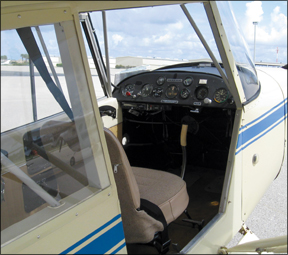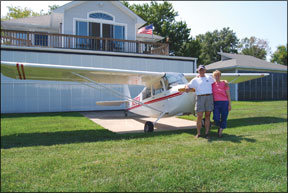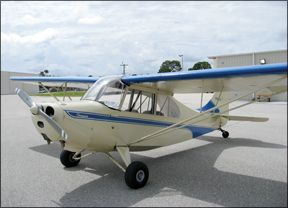Flying low and slow with the occasional whiff of honeysuckle through the open cabin window is what flying an Aeronca Champ is all about. There’s a certain romance tagging along with a rag-and-tube two-seater that’s left over from the post-World War II heyday.
Moreover, the Aeronca Champ is perhaps one of the few remaining inexpensive-to-buy, inexpensive-to-own, tandem-seaters on the market. You can even buy a new one-more on that later. Its also an LSA so sport pilots can fly it.
The first C-model Aeroncas appeared in the late 1920s with the model Ks and early Chiefs arriving in the 1930s. The popular 7AC Champion was introduced in 1945 and when production of the model 7AC Champion stopped in 1948, 7200 copies had rolled off the line.
The Champ is similar to other stark trainers of the vintage. It has conventional landing gear, sports a strut-based wing and is made of tube and fabric, of course. A 13-gallon fuel tank mounted just forward of the instrument panel feeds a diminutive 65-HP Continental engine. The year 1947 saw the introduction of Champs with more authority: the 7CCM that had a 90-HP Continental and the model 7DC that sported 85-HP. These are rare birds with only 184 DCs and 124 CCMs produced.
Production of the two airplanes ended in 1950 and 1949, respectively. Notable other postwar Aeroncas were the Chief (a side-by-side Champ) and the four-place Sedan.
The industry slowdown of the 1950s killed off Aeronca production, although the lines genes found their way into the Champions, which appeared in the mid-1950s and morphed into the better-known Citabrias, which are still built under new model names today by American Champion Aircraft (ACA). The “new” Champ labeled 7EC (not to be confused with the 1957 7EC Traveler) has been in manufacture since 1995 and is powered by the Continental O-200.
Still a bargain price
Back in the day, a new model 7AC Champ cost $2395, which was $200 more than a Piper J-3 Cub. A vintage Piper Cub is now worth more than the Champ, probably because of the standing Cub image. Most Champ owners will matter-of-factly say they own a Cub-like set of wings for far less money and have just as much fun.
For this reason, its no surprise bargain hunters caught onto the Champs appeal. The going rate for an average-condition Champ today is nearly double what the airplane was going for in 1992. The Champ (and Cub) market has changed because they are now considered classics. For years, airplanes like this were a ticket to cheap ownership. But most are now worth considerably more than many modern and newer two-seaters.
Some Champs are still cheap. The Aircraft Bluebook Price Digest pegs a 1972 7ACA Champ at an average retail of $16,000-some $2500 less than a 1977 Cessna 150. Contrast this to J-3 Cub prices that run $20K-$35K. Prices on the Champ and Cub can vary greatly and are dependent on the quality of restoration work done, and a pristine Champ can command near-Cub prices.
But with a good eye, its possible to find a bargain. One owner told us he found a pristine 7AC sitting in a barn in rural Vermont, the deceased owners wife happy to unload it. Further, the cost of ownership is about as low as it gets since you’ll burn less than 5 GPH. Better yet, many Champs have autogas STCs. Since these airplanes are so simple there really isn’t an awful lot to maintain (or break).
Flying It: use your feet
Strap into a Champ and youre sitting in one of the most basic set of wings around. No frills here. Thats not to say the airplane doesnt command respect when it comes to managing stick and rudder skills. Too often tailwheel beginners get behind on directional control and find themselves bouncing over runway lights, into the tullies or a drainage ditch. Hardly a nostalgic day.
But up at altitude, coordinated stalls are essentially a non-event. Cross-control stalls are another story. If you arent paying attention they can bite without much warning. Speaking of which, the stall warning system was still a dream when these airplanes were built so you’ll need to fly the wings and remain mindful of keeping the skid ball centered.
If you approach flying the airplane by airspeeds and not by the seat of your pants youre already off to a bad start. Your senses will eventually learn what the right numbers are.
The Champs stall behavior is much in line with two-seat airplanes of the postwar era, which likely explains the models ugly stall-spin accident record.
don’t be in a hurry to get to your destination in a Champ. You can expect to cruise at a leisurely 80 MPH. A Luscombe and speeding freeway traffic down below will outrun you. A Piper Cub wont.
Takeoff is straightforward and Champs low wing loading makes dealing with short fields childs play. Only a few hundred feet of ground run is needed. This is good because clearing tall trees with 65 HP yielding 400 FPM of climb could induce some pucker factor.
As long as you keep those cross-control stalls in the front of your mind, the Champ loves to slip and landing is fairly simple. Most owners will rave about easy wheel landings but like any taildragger, you fly it to the tiedown.
Loading, Comfort
The Champ is light. Gross weight is only 1220 pounds. But there’s not much to the basic aircraft. Expect empty weights around 740 pounds-about as much as a big motorcycle. That leaves 480 pounds of useful load, which means its a decent performer with 78 pounds of fuel, a pilot, a passenger and a couple of bags. There’s a small storage area behind the back seat.

you’ll need to be careful to always tie the airplane down or the wind will send it flying, or at least rock it hard enough to crack a wooden spar.
Cockpit visibility in a Champ is better than most postwar draggers since it has large windows. The side windows slide open for some fresh air and to lessen the stench of fuel.
But expect the Champs cabin to be drafty even with the windows closed and plan on wearing good headsets with full ear cups. All the classics of this vintage are loud. Hanlon-Wilson mufflers reduce noise somewhat. If you fly a Champ in cold weather regions, youd better dress for the occasion as the heater is essentially useless. The Hanlon mufflers do improve the heating, however.
Systems: not much there
This airplane is about as stark as it gets. There’s no electrical system (except for the later models), no flaps, no vacuum pump and few instruments. There’s a tachometer, airspeed indicator, altimeter, compass and a stark engine gauge or two. Some Champs have been fitted with a venturi to drive a turn-and-bank indicator, but don’t even try weather flying in a Champ.
Unlike the Cubs classic piano-wire-on-a-cork fuel gauge, the Champ has a dial thats shared with that in a Model A Ford. The gauge is set forward of the instrument panel which leads directly to a mechanical movement in the tank. As you would predict, these old Model A gauges can break; replacements are available though Brattons Antique Auto Parts rebuilders catalogue. Some Champ owners add redundancy by using a Cub-style wire-and-float gas cap plus the Model A gauge.
For original fuel systems, Brattons has cheap repair kits to help solve the leaking fuel nag that ultimately makes its way into the cabin. Speaking of fuel systems, the fuel selector is a simple on-off valve located on a panel adjacent to the front seat back where either occupant can reach it. The mag switch and carb heat knob are also located there. Reaching the carb heat knob from the front seat can be awkward and easily overlooked since its out of sight. Not much ergonomics in a Champ.
An STC is available for wing tanks, which increase flexibility when flying solo. With two aboard, there isn’t enough useful load to put any gas in them.
The landing gear legs have oleo struts built in, making it more streamlined than a Piper Cubs bungee arrangement. Wonderful gear, the oleo struts, but brutally expensive to replace when damaged. Proper servicing-and good landings-are the keys to gear life. Owners comment there are reliable sources for quality gear repairs.
The braking system on a Champ is hardly substantial. There are two kinds of brakes-Goodyear mechanical drums and Goodyear discs, both operated with heel levers. But this is a tailwheel airplane and having good breaks can be a setup for trouble as most wizened dragger pilots will warn. A couple of NTSB reports enforce this advice.
The wheels and hubs are subject to a recurring AD requiring an inspection for cracks. Replacements are expensive.
The original prop was wooden and more prone to wear than a metal prop. Wood props have noticeably less vibration in flight but metal ones, which are available through Wag Aero, give better performance. With no electrical system, you’ll need to brush up on your hand-propping technique.
Fixing It
Even though there isn’t much to go wrong on a Champ, working on a 1940s vintage taildragger is not like repairing even a 1970s Cessna 172.
Mechanics who are well-versed with the intricacies of maintaining old ragwing airplanes can be hard to find. It pays to find one and team up with that person before shopping for an elderly airplane. In particular, its a good idea to find someone whos good at dealing with fabric.
Two active type clubs are there to help. The National Aeronca Association (www.aeroncapilots.com) and the Aeronca Aviators

Club (www.aeronca.org) both have many excellent resources to help with maintenance and to answer questions about the airplanes. A large collection of engineering drawings exists between the two clubs and is available to restorers.
Aeronca is gone as an airplane company, but parts are available from a variety of sources, including the ubiquitous Univair, Wag Aero (who bought the previous Safe Air Repair, including PMA-approved wooden wing spars), Superior Air Parts and the Citabria people at American Champion Aircraft. ACA owns the 7AC type certificate and offers a new Champ. There are a few bits and pieces that may be hard to find, including windshields, retaining clips for the disc brakes, cranks for the Continental engine and parts for the oddball-but magnificent-Eisemann magnetos.
There are also desirable STCd upgrades available, including an O-200 engine from Cole Wagner, and a David Lasher 85-HP conversion. Wag Aero offers approved Cleveland hydraulic brakes. Slick and Bendix mags and parts are readily available, as is a 6.5-gallon fuel tank STC that increases capacity to 26 gallons (24 useable).
All Aeroncas with wooden spars have an AD to inspect for cracks. For the 7AC its a one-time compliance; with other models its a recurring inspection. You can get metal replacement spars and whole-wing replacements for the basket-case Champ.
The new champ
You can buy a new Champ from American Champion Aircraft in Rochester, Wisconsin (www.amerchampionaircraft.com). The same company that offers the Super Decathlon and Scout, among others.
Its the model 7EC and is powered by a O-200D Continental engine with 60-amp alternator, stainless steel exhaust and Sensenich 69-inch wooden propeller. There are options for avionics (some custom panels are available), electronic engine gauges, rear toe brakes, tinted windows and greenhouse roof, to name a few. There’s also an available vintage 1946 paint scheme, but its not a 1940s aircraft. The basic airplane has a starting price of $102,900.
Owner Comments
I purchased a 2007 Champ (number five off the line) from the factory. It is a Champ, but different from the 1940/50 versions. No gas tank above your knees, a Citabria metal-spar wing stressed to 5 Gs, aluminum spring gear, a Continental O-200 with an alternator and a starter, and an electrical system for things like radios, lights and transponders. Yes, it isn’t “pure” with the electrical system, but I live near Washington, D.C. and cannot get along without a radio and transponder (which are optional from the factory).
The good news is that it is just as much fun to fly as the old Champs. If you are in a hurry, however, its the wrong aircraft. Even with the extra horsepower of the O-200, 90 knots is about as good as it gets. And it is still fabric-covered, so you need to keep it inside if you expect the fabric to last. The wood prop looks classy, but has to be re-torqued every 50 hours. I live on a grass strip, and only have about 1000 feet available in the winter due to mud. The Champ does fine.
The airplane has been completely trouble free, except for the pesky starboard exhaust pipe, which has broken twice. American Champion replaced it both times with redesigned pipes at no cost. The second redesign seems to be holding.
The aircraft meets Light Sport rules, so you can fly with a drivers license, but it has a standard airworthiness certificate. One point often missed is that if an S-LSA manufacturer goes belly up, the owners have little choice but to convert their aircraft to experimental status. Also, an S-LSA aircraft owner must comply with manufacturer recommendations for parts, tires, fuel and maintenance directives. This isn’t the case with the Champ-the FAA maintains its airworthiness. If a part meets a spec or TSO, it can be used.
So if you want a fun aircraft, but need an electrical system, try the new Champ. You can see that the wife and I like this one, which is N91PV for Pat and Vince getting married in 91-you gotta sell airplanes to the wife, too.
Vince Massimini
Kentmorr Airpark, Maryland
I love my Champ. I fly large turbine aircraft for a living and I cant wait to get home to fly my 1960 7EC. It has a 90 HP with full electrics. It cost about $800 a year to insure and burns four gallons per hour. Its great fun. I look forward to teaching my kids to fly in it when they get a little older.
Sean W. Capper
via email
Ive have owned a 1946 Champ 7AC in partnership with two other people for about eight years and have accumulated about 450 hours in it. The Champ is our “fly for fun” airplane and it doesnt get any cheaper. I doubt that an ultralight could even come close. We each get the airplane for a week in rotation from Thursday through the following Wednesday.
We hangar ours (required for any fabric airplane that you care about) and our fixed expenses are $984/year for the hangar, about $360 for insurance and $140 for an annual. Thats a total of $1484 a year fixed expenses, or about $500 for each partner.
We have an auto-fuel STC and average about 4.5 GPH. At my usual 80 hours a year, my cost to fly comes out to be about $11/hour. The only big expense weve had in the eight years was a top end on all four cylinders last summer for $600. Needless to say, we do most of the maintenance ourselves under an A & Ps supervision. The airframe and A-65 engine are stone simple to work on. Unfortunately, not many mechanics understand these old airplanes and the ones that do are dying off.
Ours was acquired as a basket case and when it first flew, we each had about $1500 in it. We added two 6.5-gallon STCd wing tanks when we covered it, giving it 24 gallons usable.
Climb is anemic, cruise is at 83 MPH (faster than a Cub, slower than a Luscombe), ventilation and view are tremendous (both windows open on ours), cabin heat is nonexistent, the noise is incredible and the brakes are not to be trusted.
The gear is not as strong as a Cubs so you should avoid dropping it in, but the oil damped struts make landings smoother. You can easily operate it in and out of 300 feet (no obstructions, of course) on grass without using the brakes.
Useful load on ours is 440 pounds. With full fuel that leaves 284 pounds for people with five hours of fuel usable. A more rational 13 gallons for 2.5 hours leaves about 360 pounds for people. But the extra fuel comes in handy when youre going somewhere by yourself and wont have fuel available when you get there.
About the brakes: There are two kinds of Goodyear brakes found on the Champs. The disc brakes are better but they are held in place with clips that are made of expensivium and they occasionally pop out and get lost. The brake pads are made of the same material. Just check the Wag-Aero catalog and you’ll see what I mean.
The drum brakes are cheaper to get parts for, but there is a mandatory AD requiring inspection of the drum/hub for cracks every 50 hours. Neither brake system is very effective but that is probably a good thing with any taildragger.
The good news is that if you plan your flying so you don’t use the brakes except for run-up, you wont put much wear on them and theyll last a long time (we have yet to replace ours in 1100 hours but we have lost several clips).
Bottom line, more fun for less money than you thought possible in aviation. Forget ultralights and if you don’t have a medical, get a Champ.
Joe Scalet
via e-mail





